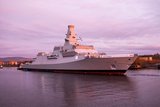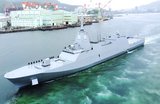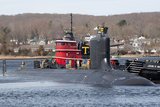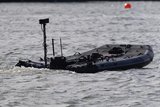Zumwalt-class destroyers begin surface-strike platform transformation
At 190m-long and displacing some 15,500 tons, the Zumwalt-class was originally designed as a land attack support platform using a 155mm gun system to provide gunfire support for forces ashore. Now it has a new role as an surface-strike platform fitted with a host of anti-ship and land-attack missiles. (Photo: HII)
The US Navy's decision to host hypersonic missiles on the Zumwalt-class (DDG 1000) destroyers has marked a significant turnaround in the future of destroyers, which were cut back following huge cost increases, delays developing critical technologies – including its new 155mm Advanced Gun System (AGS) – and the failure to find a suitable role for the vessels.
The goalposts have also moved in terms of delivering a new level of offensive firepower from the sea that rivals cannot currently match.
The US Navy contract award to Huntington Ingalls Industries' Ingalls Shipyard (HII-Ingalls), valued at US$154.8 million on 29 August 2023, will see the first-in-class USS
Already have an account? Log in
Want to keep reading this article?
More from Naval Warfare
-
![Hanwha wins Australian government approval to increase its stake in Austal]()
Hanwha wins Australian government approval to increase its stake in Austal
The contract would mean the two shipbuilders can collaborate strategically and enhance shipbuilding capabilities in Western Australia.
-
![UK to join US Navy’s Virginia-class submarine assembly effort to speed up construction]()
UK to join US Navy’s Virginia-class submarine assembly effort to speed up construction
The expansion of the Virginia-class submarine construction to UK shores could accelerate the project as US shipbuilders continue to fall short of delivery goals.
-
![US Navy seeks new sensors for the CH-53K King Stallion heavy-lift helicopter]()
US Navy seeks new sensors for the CH-53K King Stallion heavy-lift helicopter
The US Navy intends to publish a draft request for proposals in Q2 2026 and conduct an open competition for the supply of new electro-optical and infrared capabilities for the CH-53K heavy-lift helicopter.
-
![NATO naval exercises map out future USV requirements but raise questions on acquisition]()
NATO naval exercises map out future USV requirements but raise questions on acquisition
Uncrewed surface vessels have shifted from a desirable capability to a critical one for navies. But should these systems be bought outright, rented as a service or rapidly built using commercial off-the-shelf components?























